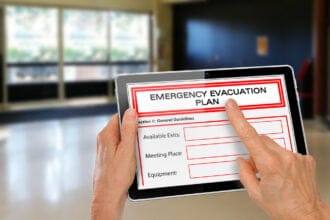

What strikes your mind first when you hear about disaster recovery? One can say recovery or continuation of systems and proper functioning of systems after occurrence of any disaster. If we talk about disaster recovery in the world of cloud computing, the term Disaster Recovery is quite new. But are you aware of top cloud disaster recovery concerns? And are you sure disaster recovery in the cloud option that you have chosen is a good choice for your organization? Let’s find out answers for such questions.
The concept of Disaster Recovery on Cloud (DRaaS) is still emerging, including some of its products and services. Small and medium-sized enterprises have started leveraging cloud services for Disaster Recovery. Deploying Disaster Recovery sites in the cloud minimizes the necessity for IT infrastructure, data center space and IT resources leading to substantial reduction in costs, thereby enabling smaller organizations to determine DR solutions which were previously discovered in larger organizations. With cloud-based disaster recovery, there is a shift of discussion from data center space to cloud capacity planning.
Just like no human being is perfect, similarly, every solution developed is not perfect. Perfection is an anomaly. It is better to comprehend the benefits and limitations of disaster recovery in cloud before deploying the solution. Designing your backup sets for recovery is very important if one uses cloud-based backups as a part of its Disaster Recovery. Other considerations are the ability to serve users, its availability and reliability of cloud service provider.
Planning a DR in the cloud blueprint
You cannot plan a single blueprint for DR in cloud just like traditional DR. Every organization is unique as per the applications it runs as well as the relevance of the applications to the business and the industry in which the organization operates. So, a cloud disaster recovery plan will vary organization to organization. Triage is one such principle which is used to derive cloud-based disaster recovery plans. This principle is used in traditional DR plans as well. The process of Disaster Recovery plan is summarized as:
- Identify and Prioritize applications, data and services
- Calculating the downtime for each applications, services and data
- Identify all acute resources and recovery methods
- Determine the cost effective ways for attaining the RTO’s.
Disaster recovery in the cloud alternatives
After deciding the blueprint, different disaster recovery solutions in the cloud alternatives are available for organizations to choose. Let’s review disaster recovery solutions.
Managed Disaster Recovery and Managed applications.
One of the most renowned options is to put DR instances and primary production into the cloud and get it handled by a MSP (a managed service provider). From removing on-premises infrastructure to usage based cost, one can gain all the benefits of cloud computing. Rather doing it yourself manually, one can concede disaster recovery to managed service provider or to the cloud. Utmost importance should be given to the procedure of negotiating suitable service-level agreements (SLAs) and selecting the service provider. By dispersing the control to the service provider, one needs to be completely certain that the service provider is able to provide uninterrupted service within the defined framework of SLA’s for DR and primary instances. A typical cloud game is increasingly gaining wide acceptance for email and some other business applications like customer relationship management.
Backing up and restoring from the cloud
In this approach, data and applications stay on-premises while data is backed up in the cloud and when a disaster occurs data is restored onto premise hardware. In short, substitute of tape-based off-site backups is a backup in the cloud.
It’s crucial to have a clear understanding of some problematic restore features and backup when the process of envisaging cloud backup and recovery is carried. Truly speaking, the process of backing up into the cloud is pretty direct. Moreover, back application providers are now extending their back up solutions with alternatives backing up with renowned cloud service providers directly. Similarly, cloud gate ways can be deployed to move data into the cloud. Cloud gateways include both cloud storage and on premise storage and keep both data in cloud and on premise data in sync.
Recovery becomes the most perplexing aspect for deploying cloud-based backups for disaster recovery. Having bandwidth limitation and recovering terabytes of data, restoring data back on premise can be difficult. Certain cloud backup vendors offer option of restoring data to disks, which then the customer receives it to carry out on premises recovery. Alternative choice is a huge on-premises cache of recent backups which can be utilized for local restores.
If we are dependent on data to be restored, certain features such as compression and data depude which is very important make restores from data to on-premise infrastructure from cloud a feasible option.
Backing up and restoring to the cloud
Talking about this approach, restoration of data does not take place to on-premise infrastructure rather it is stored to virtual machines in the cloud. For this you require both cloud compute resources and cloud storage. The process of restoration can be done when a disaster is pre-staged or is just declared. Keeping disaster recovery VM’s pre staged and up to date via scheduled restores is critical especially where forceful RTO’s have to be met. Certain cloud service providers extend cloud VM’s as part of their disaster recovery solutions.
Replicate data to virtual machines in the cloud.
Some applications take a lot of recovery time, RPO’s (recovery point objectives) and awareness regarding applications. In such situations, replication to virtual machines is the data shifting option. This solution can deployed for protection of both on-premises production instances and cloud. Replication is appropriate for cloud virtual machines to cloud virtual machines as well as on-premises to cloud virtual machines data protection.
The cloud widely offers disaster recovery options resulting in noteworthy cost savings. However, the disaster recovery fundamentals are not changed for devising a concrete disaster recovery plan which ensure periodic testing and training users and preparing them applicably.









